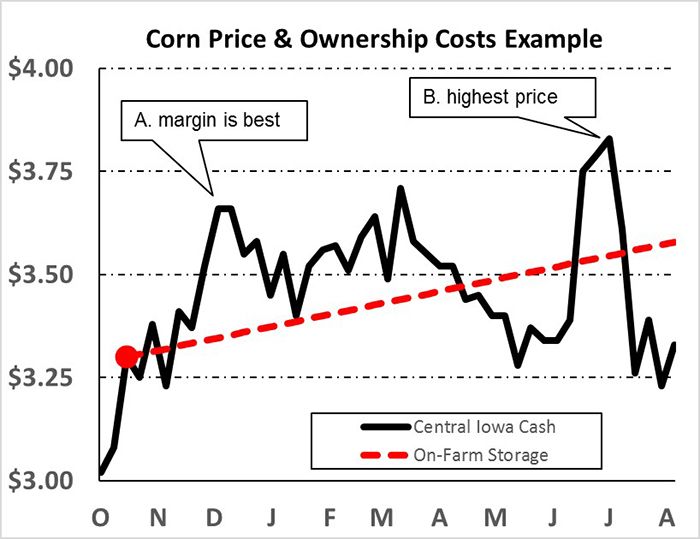Taking on the challenges of post-harvest crop marketing
Author
Published
9/1/2016
Marketing crops after harvest is challenging. The uncertainties of price direction, costs of bushel ownership, emotions and more all factor into making the decision to move grain from storage to market a difficult management decision.
For many, the 2016 corn and soybean crop will be large and many bushels are destined for storage. Often when faced with a demanding situation like marketing a stored crop, it is best to break it down into manageable parts. Here’s a few considerations to help stimulate thoughts about the store/sell decision.
Post-harvest basis strength
Traditionally, the basis portion of local price can be the weakest at harvest. This is because harvest time is often the slot when bushels are most plentiful–the commercial grain buyer does not need to tighten basis to purchase enough bushels. Once harvest is near completion though, bushels become more difficult to procure and buyers often tighten basis to get supplies.
The adjacent chart shows this pattern for the average basis trend over the last four years for an example central Iowa location. For this example location, you can easily see that a huge percentage of the basis gain versus March futures can occur by 60 days after the weakest harvest basis.
This basis strength can be helpful for those with unpriced bushels and especially bushels that are priced using a futures instrument (sold futures, hedge-to-arrive contacts, etc.).
If marketers stay attentive and know their local basis pattern, much of the basis gain can be captured in the first 45 to 60 days after harvest without long-term storage.
Storage objectives
Once bushels are committed to storage, price is not necessarily the objective. We can become so focused on price that real returns slip out of our hands. The real objective should be a margin above costs of ownership.
One perspective is to compare margin above cost to price.
For example, the graph on the right depicts a central Iowa cash corn price from a recent crop marketing year.
This example is selected to show that the highest price is not necessarily the best return. The costs of ownership (solid red line) represent 5 percent interest plus 1.5 cents per month. At point A (December) the margin above costs of ownership is 32 cents per bushel. At point B (July), price is at the highest in the time period shown, yet margin is less per bushel than was offered in December. The example shows that the highest price is not necessarily the best margin. Each farm operation should calculate their own costs of ownership.
Stored bushels should have a margin goal, not a price goal. In addition, consider all the additional price risk experienced between points A and B.
Inaction can be a risky method to deal with bushels in storage.
Having a margin goal is important, but there isn’t a guarantee that the market will give you an opportunity to sell at that goal. What then?

Discipline of deadlines
One way to combat procrastination problems can be to have the discipline of self-imposed deadlines. In other words, setting specific dates to move bushels out of storage should be part of a plan.
Using seasonal basis or price patterns is one method of placing deadlines on moving bushels.
For example, having a specific percentage of stored bushels sold by May. Breaking down the bushels into smaller increments and having a number of deadline dates can help to mitigate price risk. Spreading out the pricing points helps to alleviate the pressure of picking the "right" price. Always consider your cash flow responsibilities in the timing of sales.
The difficult task of marketing stored bushels can have a paralyzing effect on future opportunities.
In recent years, old-crop inventories have been high. It can be tough to concentrate on future tasks with the concern of stored bushels.
In particular, taking advantage of early new-crop pricing opportunities can be especially challenging with old-crop bushels on your mind. Remember as long as you have more bushels to sell or if you will be producing bushels next year, you should always be cheering the market higher.
Certainly, there is no one way to merchandise old-crop bushels. Employing these ideas and using a variety of tools spread over many pricing decisions can help with the challenge of marketing stored bushels.
For more on market planning, tracking basis and costs of ownership, go to the Marketing Tool Workbook and other resources at http://tinyurl.com/iacrops.
Kordick is the Iowa Farm Bureau Federation’s commodity services manager.
Want more news on this topic? Farm Bureau members may subscribe for a free email news service, featuring the farm and rural topics that interest them most!